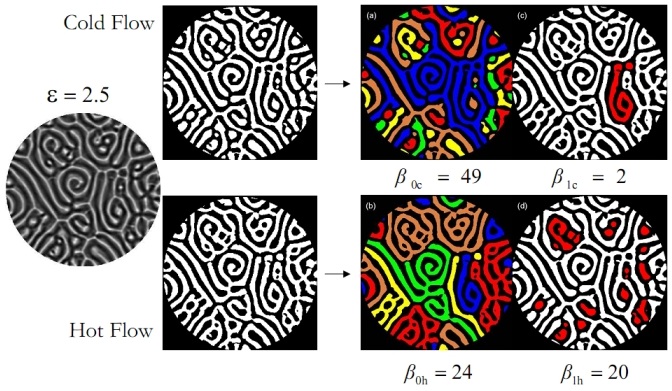Research
Characterization of Complex Patterns
When physical systems are driven far from equilibrium they often produce complex structures (patterns) that can be aperiodic in both space and time. Examples of pattern-forming systems include lasers, cardiac tissues, and planetary atmospheres. Today, it is possible to measure the dynamical behavior of these systems with high spatial and temporal resolution. However, characterizing the resulting data sets still poses significant challenges. Our group uses a variety of pattern characterization techniques to analyze spatiotemporally chaotic data from Rayleigh-Bénard convection (RBC) experiments.

Rayleigh-Bénard convection is a paradigm in the study of pattern-forming systems. Our experimental implementation consists of a pressure cell containing a thin layer of compressed gas, which is cooled from above and heated from below. When the temperature difference ε across the gas exceeds a critical value, the fluid begins to flow. This is visualized using shadowgraphy, which exploits the temperature dependence of the index of refraction of the gas. When the temperature difference is small, the system forms a series of parallel convection rolls. As the temperature difference is increased, driving the system further from the equilibrium, the convection patterns become progressively more complex. Eventually, the system reaches a state known as spiral-defect chaos, shown in the video below.
The resulting images can be analyzed to answer a variety of questions about convective flows. These data sets can be enormous, sometimes containing millions of images, so they must be analyzed using large computer clusters, such as Georgia Tech's PACE cluster, and parallel algorithms. In the past, we have used traditional techniques such Karhunen–Loève decomposition (principle component analysis) and Fourier analysis to characterize convection patterns. More recently, we have added algebraic topology (homology) to this toolbox and used it to show how asymmetries arise between cold and hot flows as a result of the temperature dependence of the fluid parameters.

Representative Publications
- H. Kurtuldu, K. Mischaikow, and M.F. Schatz, "Measuring the departures from the Boussinesq approximation in Rayleigh-Bénard convection experiments," J. Fluid Mech. 682, 543-557 (2011).
- H. Kurtuldu, K. Mischaikow, and M.F. Schatz, "Extensive Scaling from Computational Homology and Karhunen-Loeve Decomposition Analysis of Rayleigh-Bénard Convection Experiments," Phys. Rev. Lett. 107, 034503 (2011).
- K. Krishan, H. Kurtuldu, M.F. Schatz, M. Gameiro, K. Mischaikow, and S. Madruga, "Homology and symmetry breaking in Rayleigh-Bénard convection: Experiments and simulations," Phys. Fluids 19, 117105 (2007).
© 2013 Schatz Pattern Formation and Control Lab | Last updated: 12-10-2013
